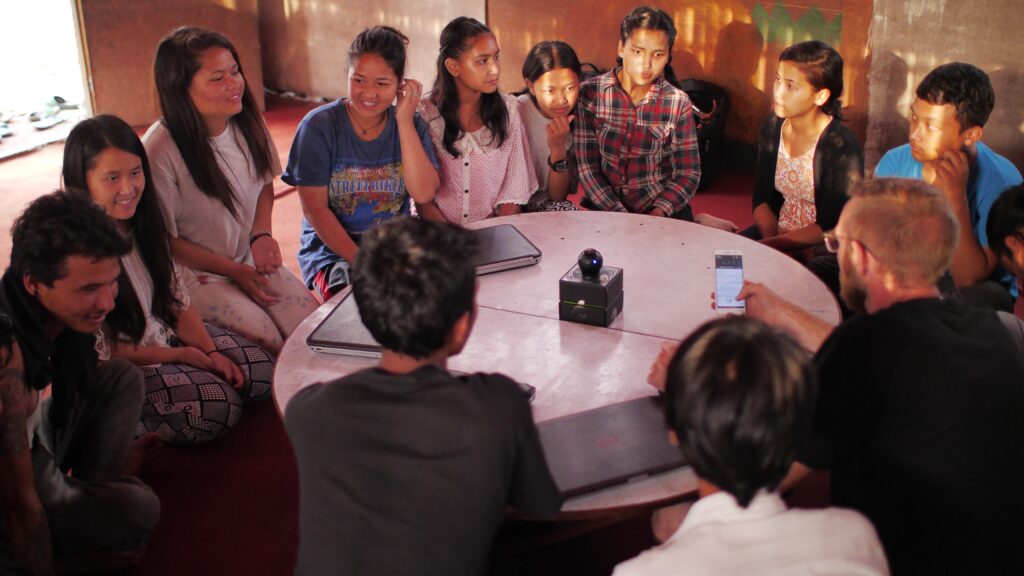Introduction
For many introverts, the prospect of engaging in small-talk during volunteer work might seem daunting. Yet, it’s a skill that can be honed and mastered with practice. This article aims to demystify the process, providing clear and straightforward guidance on how to excel in small-talk, ultimately enriching your volunteering experience. For those intrigued by the introvert to extrovert transition, it’s worth noting that improving small-talk abilities is a pivotal step in that journey. Embracing this challenge not only enhances one’s volunteering endeavors but also contributes positively to personal growth and social confidence. So, let’s delve into the practical ways introverts can connect and thrive in volunteer settings through small-talk. 👥✨

Introduction to Small-Talk in Volunteering
As we begin exploring the realm of small-talk in volunteering, it’s crucial to first understand its significance and the role it plays in fostering connections. Small-talk acts as a gateway for deeper, more meaningful interactions, providing a foundation for trust and rapport. For introverts, mastering this art can seem like a steep hill to climb, but the rewards are worth the effort. It’s not about changing who you are, but rather enhancing your communication toolkit to navigate social settings more comfortably and effectively. To gauge where you currently stand and identify areas for improvement, consider taking our comprehensive introvert test. This will provide valuable insights and serve as a starting point for your journey towards small-talk proficiency.
In volunteer settings, small-talk is more than just idle chit-chat; it’s a tool for creating a positive and inclusive environment. When volunteers are able to engage in light, casual conversations, it breaks down barriers and fosters a sense of community. This is especially important in projects where teamwork and collaboration are key to success. For introverts, the trick lies in finding balance – knowing when to listen and when to contribute. It’s about being present in the moment and showing genuine interest in the people around you.
Embracing small-talk doesn’t mean you have to be the life of the party or dominate every conversation. It’s about creating openings for connection, making others feel seen and heard, and building bridges between diverse groups of people. With practice, introverts can not only excel in small-talk but also discover the joy and satisfaction that comes with making meaningful connections in volunteer settings. 🤝🌟

Breaking the Ice: Strategies for Starting Conversations
Delving further into the world of small-talk, it becomes essential to equip yourself with strategies for initiating conversations, especially in volunteering scenarios. This is where introverts can truly shine, as their thoughtful and observant nature can be a significant asset. At the onset, joining our intro to extro community could provide a safe space for discussion and sharing insights on this topic. It’s a platform where like-minded individuals gather, allowing for exchange of experiences and tips on navigating social interactions as an introvert.
One of the most effective ways to break the ice is to come prepared with open-ended questions. These are inquiries that cannot be answered with a simple ‘yes’ or ‘no’. Instead, they encourage the other person to share more about themselves. Asking about someone’s reasons for volunteering, their interests, or their experiences in the project can open doors to engaging and meaningful conversations.
Another key aspect is to pay attention to non-verbal cues. People’s body language can often tell you more about their mood and willingness to engage in a conversation than their words alone. For introverts, this attention to detail can be a strong suit, aiding in navigating social interactions with ease.
Moreover, it’s important to remember that small-talk is a two-way street. Sharing a bit about your own experiences and thoughts in response to others’ stories can create a balanced interaction, making the conversation flow naturally. It shows that you are not just there to ask questions but are also willing to open up and contribute to the dialogue.
In the volunteering context, being able to initiate and sustain small-talk can significantly enhance the experience, making it more fulfilling and enjoyable. For introverts willing to step out of their comfort zone and apply these strategies, the benefits extend beyond the volunteering space, fostering improved social skills and confidence in various aspects of life. 👥🌟

Connecting with the Community: Small-Talk in Action
Engaging with the community is at the heart of most volunteering ventures. It’s here that the power of small-talk truly comes into play. To aid in this process, our intro to extro roadmap is an invaluable guide, distinguishing itself with its unique approach tailored for the introvert’s journey. The roadmap provides insights that are different from conventional ones, ensuring that introverts have a clear path to enhance their communication skills.
In the community setting, small-talk isn’t merely about exchanging pleasantries. It’s an avenue to understand the needs, concerns, and aspirations of the individuals you’re serving. By initiating light conversations, volunteers can uncover essential insights that might be missed otherwise. For instance, a simple chat with a local resident might reveal the most pressing needs of a community, helping volunteers to tailor their efforts more effectively.
For introverts, connecting with the community via small-talk can be seen as a series of small steps. Beginning with listening — a natural strength for many introverts — is key. By genuinely listening to the stories, challenges, and joys of community members, volunteers can establish trust and rapport. From there, offering empathetic responses or sharing similar experiences can deepen these connections, making community members feel valued and understood.
It’s also worth noting that consistency plays a role. Regular interactions, even if brief, can build familiarity and trust over time. This iterative process of engaging, listening, and sharing helps weave the fabric of a strong community connection. Over time, what starts as simple small-talk can evolve into impactful relationships, with introverts positioned as bridge-builders between volunteering organizations and the communities they serve. Through these connections, volunteers can ensure that their efforts resonate deeply, creating lasting positive change. 🌱🤝🌍

Using Body Language to Enhance Small-Talk
As we delve deeper into the nuances of small-talk in volunteering, the role of body language cannot be overstated. While words lay the foundation of communication, non-verbal cues add depth and sincerity, creating a fuller, more genuine interaction. For introverts, honing in on this aspect can significantly enhance their ability to connect and communicate effectively in volunteer settings.
Body language encompasses a range of expressions, from facial expressions and eye contact to gestures and posture. Maintaining eye contact, for instance, signals attentiveness and interest, showing the person you are speaking with that you are fully present in the conversation. On the other hand, a warm smile can break barriers, making the interaction feel more open and friendly.
Posture also plays a critical role. Standing or sitting up straight conveys confidence, while leaning in slightly shows engagement and interest. Being mindful of these subtle cues can create a welcoming atmosphere, encouraging open communication and fostering connections.
However, it’s important to strike a balance. Overemphasizing certain gestures or expressions can come across as insincere or overwhelming. The key is to remain natural and authentic, letting your body language flow seamlessly with the conversation. For introverts, this may mean being more conscious of their expressions and gestures initially, but with practice, these elements will become second nature.
Incorporating effective body language into small-talk not only enhances the quality of interactions in volunteering but also contributes to building trust and rapport. It helps bridge the gap between words and intentions, ensuring that your message is conveyed clearly and sincerely. For introverts looking to thrive in volunteering, mastering the art of body language is a step towards creating more meaningful and impactful connections. 🗣️🤝🌟
Adapting Your Communication Style for Different Audiences
The ability to adapt your communication style to suit different audiences is crucial, especially in the varied landscape of volunteering. Recognizing that each individual is unique, with their own preferences and cultural backgrounds, is key to effective small-talk. For introverts, this might mean stepping out of their comfort zone, but the rewards in terms of connection and understanding are well worth it.
Adapting your communication style goes beyond just the words you choose; it encompasses your tone, body language, and even the pace of your speech. When engaging with elderly individuals, for instance, a gentle tone and clear articulation can make the conversation more accessible and enjoyable for them. On the other hand, volunteering with children might require a more energetic and expressive style to capture their attention and build rapport.
Being observant and responsive to non-verbal cues can provide valuable information on how well your communication style is being received. If the person you’re speaking to seems disengaged or uncomfortable, it might be a sign to adjust your approach. For introverts, this attentiveness to detail is a natural strength, allowing them to pick up on subtle cues and modify their communication style accordingly.
Importantly, adapting your style doesn’t mean completely transforming your personality. It’s about finding a balance that suits both you and the person you’re interacting with, creating a space for mutual understanding and connection. This skill is particularly valuable in volunteering, where you encounter a diverse range of individuals, each with their own stories and perspectives.
Mastering the art of adapting your communication style not only enhances your effectiveness as a volunteer but also contributes to your personal development. It fosters empathy, enhances social awareness, and equips you with the skills to navigate diverse social interactions, ultimately enriching your volunteering experience and beyond. 🌍🤝💬
The Do’s and Don’ts of Volunteer Small-Talk
Navigating the art of small-talk in volunteering necessitates a clear understanding of what works and what doesn’t. For introverts aiming to enhance their communication skills, being mindful of these do’s and don’ts is vital. It ensures that conversations are not just exchanges of words, but pathways to meaningful connections.
Do: Be Present and Attentive: This involves actively listening and showing genuine interest in the conversation. Make eye contact, nod in agreement, and provide verbal cues to show that you are engaged. This creates a positive atmosphere and encourages open communication.
Do: Find Common Ground: Identifying shared interests or experiences can be a game-changer in small-talk. It provides a comfortable topic to discuss, making the conversation flow more smoothly and building a sense of camaraderie.
Do: Be Open and Positive: Maintain a positive demeanor and be open to different topics of conversation. This doesn’t mean you have to agree with everything, but keeping an open mind encourages diverse discussions and shows that you are approachable.
Don’t: Dominate the Conversation: Ensure that the conversation is balanced. Give the other person a chance to speak and share their thoughts. Dominating the conversation can be overwhelming and counterproductive.
Don’t: Dive into Controversial Topics: Unless you are certain of the other person’s stance and comfortable discussing it, avoid delving into controversial or sensitive topics in initial conversations. Keeping the conversation light and neutral helps establish a comfortable space for interaction.
Don’t: Be Distracted: Avoid looking at your phone or around the room while conversing. This can come across as disinterest, making the other person feel undervalued.
Incorporating these do’s and don’ts in your approach to small-talk not only enhances your effectiveness as a volunteer but also contributes positively to your interpersonal skills. For introverts, this is a step towards more meaningful interactions and a richer volunteering experience. 🤝✨💬
Conclusion
In conclusion, mastering the art of small-talk is a transformative journey, especially for introverts engaged in volunteering. It’s about leveraging your innate qualities, such as attentiveness and thoughtfulness, to forge meaningful connections and create a positive impact. By embracing strategies to initiate conversations, adapting your communication style to different audiences, and being mindful of your body language, you unlock the potential for deeper, more fulfilling interactions. Remember, it’s not about changing who you are, but enhancing your ability to connect and communicate. Volunteering offers a unique platform to practice and hone these skills, contributing not just to the success of the initiatives you are part of, but also to your personal growth and social confidence. The journey from introversion to a more extroverted communication style doesn’t have to be daunting; it’s a path filled with learning, growth, and the joy of connecting with others. So, embrace the challenge, celebrate the small victories along the way, and watch as your efforts transform not just your own experience, but the entire volunteering community around you. 🌟🤝




